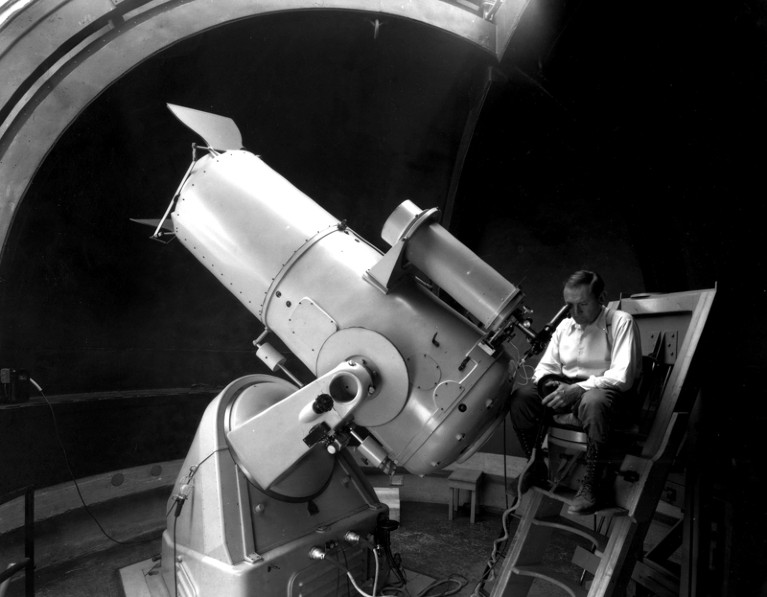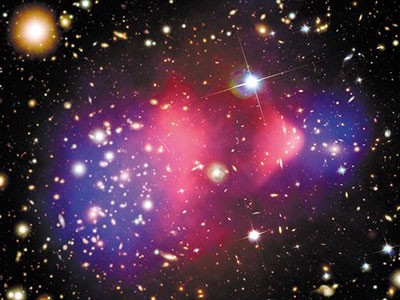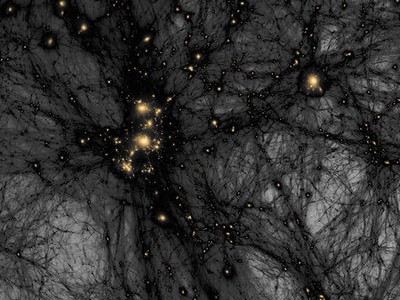
Fritz Zwicky at the Schmidt telescope at Palomar Observatory, California, in the 1930s.Credit: Palomar Observatory/Caltech
Zwicky: The Outcast Genius Who Unmasked the Universe John Johnson Harvard (2019)
Fritz Zwicky advanced astronomy over much of the twentieth century, pioneering findings on constituents of the cosmos from supernovae and neutron stars to dark matter and compact galaxies. He worked at two of the world’s most historically important observatories: Mount Wilson and Palomar in California. He was an early innovator in jet-engine design. Yet the Swiss astronomer is a somewhat elusive figure in the history of science. Science journalist John Johnson seeks to rectify that in his spirited biography, Zwicky.
As Johnson reveals, the very boldness and ingenuity of Zwicky’s discoveries could work against him: many were viewed as unconventional, and were confirmed only years after he made them. Zwicky also had a reputation for abrasiveness. For instance, he reportedly called some of his colleagues at the California Institute of Technology (Caltech) in Pasadena “spherical bastards” (meaning, from whichever angle you looked at them). Johnson’s book unravels these two sides of Zwicky — the brilliance and the ire — by framing him as an “outcast genius”. But can this portrayal help to change perceptions of the prolific astrophysicist?
Zwicky trained in physics and mathematics at the Swiss Federal Institute of Technology in Zurich. In 1925, the Rockefeller Foundation in New York City offered him a fellowship to study the physics of crystals at Caltech with the Nobel-prizewinning experimental physicist Robert Millikan. Two years later, he shifted fields. He began to research galaxies at Mount Wilson alongside Edwin Hubble, the astronomer who would find evidence for the expansion of the Universe in 1929. Zwicky himself soon produced a series of intriguing theories and observations.
Zwicky is celebrated mainly as the ‘father of dark matter’. In the early 1930s, while studying Hubble’s observations of the Coma Cluster of galaxies, he noted an anomaly. According to the measure of visible mass, single galaxies were moving too fast for the cluster to remain bound together. Zwicky posited that an as-yet unobserved type of mass, dunkle Materie (dark matter) might explain it, and in 1933 he presented his findings in the journal of the Swiss Physical Society. However, it took another three decades for the phenomenon to be observed widely. And only after Zwicky’s death, in 1974, was dark matter accepted as part of the cosmological canon, through the work of radio astronomers, cosmologists and particle physicists.
Zwicky’s star soon rose. In 1934, he and Walter Baade identified the existence of supernovae, the explosive final stage of a star’s life. Zwicky posited that novae launched a sea of particles into space that might account for cosmic rays, the then-unexplained phenomenon observed by Nobel laureate Victor Hess in 1912, during experiments conducted in a balloon. When the theory was made public, Zwicky’s career exploded, and he became “the darling of reporters everywhere”, Johnson writes.
Johnson touches on many other examples of Zwicky’s prescience during his Caltech years. Again with Baade in 1934, he predicted the existence of neutron stars, extremely dense bodies of neutrons left behind after a supernova. In 1937, he was the first to argue that galaxies, like stars, could act as gravitational lenses, bending light according to Albert Einstein’s general theory of relativity. And in the 1940s, his search with Milton Humason for white dwarfs — another class of dense stellar remnants — gave early hints of the highly energetic outbursts that came to be known as quasars. Johnson tells the story well, but does not delve much into the science behind the insights.
As a scientist, Zwicky went his own way, tending to study phenomena outside trends in stellar astrophysics. His professional animosities, however, were actively divisive. Johnson notes that Zwicky despised what he saw as unoriginal “grey thinking” in fellow researchers. He called theoretical physicist Richard Feynman a “spiritual coward”, and was contemptuous of astrophysicists who adhered to the theory of an expanding Universe. Johnson contends that after Zwicky’s retirement in 1968, he was barred from using the telescopes at Mount Wilson and Palomar, owing to a quarrel with Hubble’s protégé Allan Sandage.
Cosmology: Matter and mixology
Johnson reveals other facets of the astronomer. He points to Zwicky’s dedication to his family, and his determination to use science as a tool for human progress. Along with his extraordinary discoveries, Zwicky formulated schemes such as turning asteroids into habitable planets and — in another discerning moment — colonizing the Moon. Just as inventive was his methodology, which he dubbed “morphological analysis”. In essence, this is a problem-solving technique for exploring all possible solutions to any complex issue, from learning languages to computing astrophysical quantities. Although Johnson does not describe it in depth, Zwicky clearly found it essential to doing good, creative science.
For instance, in 1943, he used the method in researching and developing a jet engine at Aerojet, a rocket-manufacturing company that at the time was based in Pasadena, California. It worked. Zwicky became a force in US rocket science, and in 1945 he was the first to interview Werner von Braun — the engineer of the German V-2 rocket who became a crucial asset to the US space programme. Zwicky’s contributions to the US Air Force were considered so valuable that he received the Medal of Freedom from then-president Harry Truman in 1949.
Zwicky also wrote several books on his methodology. In the 1971 Jeder ein Genie (‘Everyone a Genius’), he argued for morphological analysis as a universal technique for developing intellectual prowess. However, genius is a slippery concept, and Johnson’s use of the term to describe Zwicky is risky. A genius is a person apart, a ‘wonder’ who evades explanation. The characterization is distancing, hindering our understanding of the person as a product of their era.
Readers seeking that understanding might find Johnson’s book too anecdotal, and lacking in the context needed for an integrated portrait. Zwicky was part of a new generation of early-twentieth-century astrophysicists, probing the cosmos beyond the Milky Way. And he was an émigré in a war-torn era. If Johnson had more thoroughly explored what linked the man and his work to these historical developments, what insights might have emerged?
To some degree, then, Zwicky remains elusive. Nevertheless, Johnson’s book is rich enough to inspire interesting meditations on research, idiosyncrasy — and reputation.


 Cosmology: Matter and mixology
Cosmology: Matter and mixology
 Astronomy: The great unseen
Astronomy: The great unseen








